Economic conditions of crofting 2015-18: survey
This report provides a detailed outline of the uses and financial situation of crofts in the years between 2015 and 2018.
4. Financial issues in crofting
4.1 Crofters were asked to approximate their revenue from crofting-based activities in the last twelve months, including any agricultural support funds such as the CAP Rural Payment or funding from the Scottish Rural Development Programme, to the nearest £100.
4.2 Revenue[10] from crofting activities in the last twelve months varied enormously from nothing to over £100,000, while the median revenue reported was £2,000, unchanged since 2014. As shown in Figure 4.1, over half of those that reported some revenue (56%) had received £5,000 or less and a quarter of crofters (25%) reported no revenue in the last 12 months[11]. The mean revenue reported was much higher than the median, at £13,095, indicating a small number of very high responses.
4.3 As this question was answered by only three quarters (74%) of those who completed the survey, it is possible that the below pie chart overstates overall revenue levels due to non-response among non-earners. There is also a possibility, however, that some high income earners did not report their revenue and that overall revenue levels are therefore more polarised than the chart suggests.
4.4 While the mean revenue had increased significantly since 2014, from £4,900, the proportion of those reporting no revenue at all had also risen considerably, from 18% in 2014 to 25% in 2018.
Figure 4.1 Q Approximately what was your revenue before deducting costs from crofting-based activities in the last 12 months (excluding agricultural support funds)?
(Base: 546)
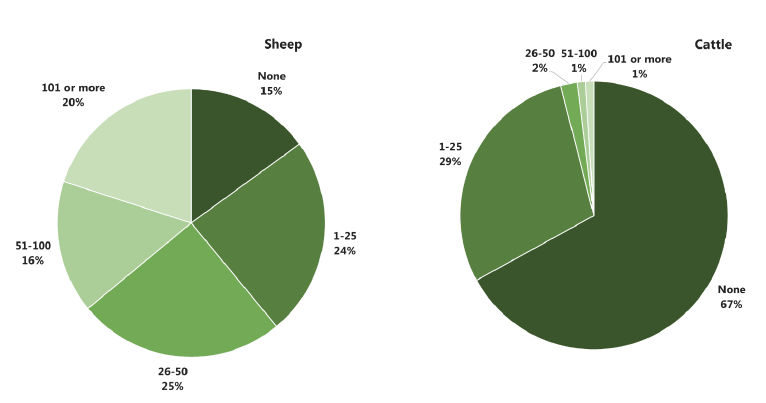
4.5 Those who had been crofting for more than 20 years reported the highest median revenue at £3,000, while those who had been crofting less than three years were the most likely to report no revenue, with over half of crofters (58%) from this group reporting “nothing”. However, this should be interpreted with caution as the base size is very small. Only 38 crofters had been crofting for less than three years so 58% equates to 22 that reported “nothing”.
4.6 There was no significant difference between the median or mean revenues reported between owner-occupier and tenant crofters. While the mean and median revenue figures varied considerably between local authorities, with the latter shown below, the base sizes were too small for these differences to be significant.
Table 4.1 Median revenue by local authority and by tenure status (Base: 546)
| Median revenue | |
|---|---|
| Tenure Status | |
| Tenant (550) | £3,967 |
| Owner-occupier (180) | £4,988 |
| Local authority | |
| Argyll and Bute (25) | £2,602 |
| Highland (312) | £4,183 |
| Eilean Siar (306) | £2,100 |
| Orkney Islands (14) | £20,000 |
| Shetland Islands (73) | £9,511 |
4.7 As can be seen in Figure 4.2, the vast majority of crofters (81%) thought their revenue was not likely to change over the next twelve months, while six per cent anticipated an increase and 12% a decrease. This represents a decrease by around half both among those expecting an increase in revenue (from 14%) and among those expecting a decrease in revenue (from 22%), with a considerable rise in the numbers anticipating no change (from 63%).
Figure 4.2 Q How do you anticipate this will change over the next 12 months? (Base: 448)
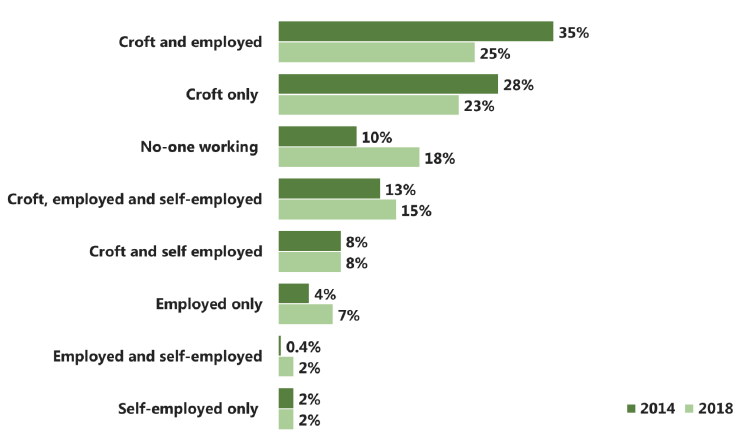
4.8 The majority of crofters (73%) reported no running costs related to their crofting-based activities or running costs of under £5,000, as shown in Figure 4.3. The three most common responses were up to £1,000, £1,001-£5,000 and Nothing at 30%, 30% and 13% respectively. Almost three in ten (29%) respondents did not report their running costs, however; thus the proportion with no running costs could be considerably higher than the results indicate. The median running cost reported was £2,000 (while the mean was £8,385).
Figure 4.3 Q Approximately what were your business running costs related to your crofting-based activities in the last 12 months? (Base: 519)
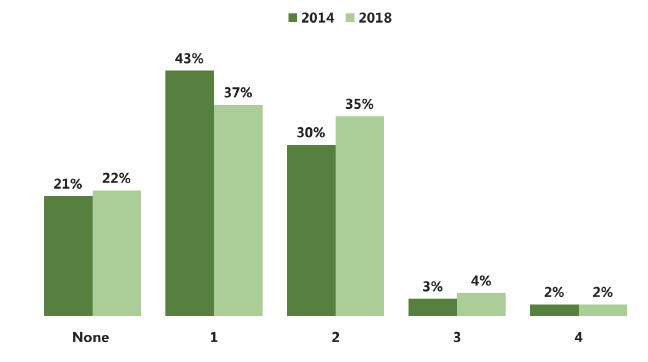
4.9 Crofters were also asked about their total household income from all non-crofting activities in the last twelve months including all sources of paid employment and pensions as well as interest on bank deposits and investments.
4.10 The median household income reported from non-crofting activities was £25,000, up from £21,000 in 2014. As shown in Figure 4.4, just under a third (32%) of crofters reported an income of £10,001-£25,000, with the same proportion (32%) reporting an income of £25,001-£50,000. The mean income reported for the last year was considerably higher than the median, at £41,760, up from £27,500 in 2014, which can be attributed to a small number of very high responses.
4.11 The median combined revenue from both crofting and non-crofting activities, minus business running costs was £29,000, higher than the median Scottish household income of £25,200[13].
Figure 4.4 Q Approximately, what was your total household income from all non-crofting activities in the last 12 months? (Base: 514)

4.12 Most crofters (84%) anticipated no change in their income over the next twelve months with just 7% expecting an increase and 8% anticipating a decrease.
4.13 When asked about paying for land rent/mortgage costs, around six in ten (57%) crofters reported having rental or mortgage costs. Among those who did, as Figure 4.5 illustrates, it was most common for them to be paid separately at 48% and just 9% reporting that they are paid together. These results were all largely consistent with the results in 2014.
Figure 4.5 Q Do you pay for your land rent/mortgage together with your housing rent/mortgage? (Base: 640)
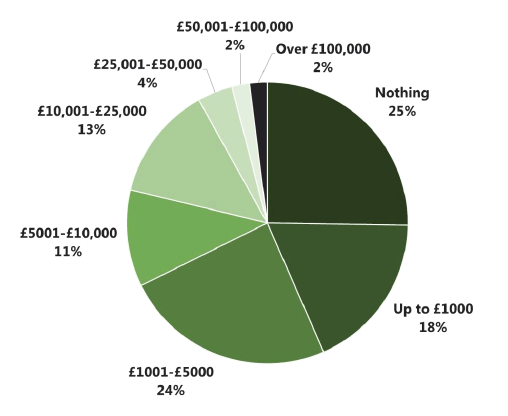
4.14 Those who had rental or mortgage costs were asked what their costs for housing were in the last twelve months. As Figure 4.6 illustrates below, these costs varied enormously from nothing to over £25,000. While almost one fifth of crofters (18%) reported no housing costs and 44% did not state their costs, the median response was £1,029, while the mean response was £3,549. Around a quarter (24%) of crofters who answered this question reported costs of £1,001-£5,000, and a further one in five reported costs of £5,001-£10,000 (20%) and costs of up to £1,000 (18%).
Figure 4.6 Q Approximately, what were your rent/mortgage costs in the last 12 months for housing? (Base: 214)

4.15 Compared to 2014, there has been an increase both in the proportion of crofters that pay rental/mortgage costs for their housing and in the average costs. While the proportion of those paying nothing has decreased from 52% to 32%, the mean cost has risen from £1,500 per annum to £3,549.
4.16 The average land rental and mortgage costs were much lower, with a median annual cost of just £64 and a mean cost of £741, though these have also risen considerably since 2014, from £25 and £270 respectively.
4.17 As can be seen in Figure 4.7, over three quarters of crofters (77%) reported costs of up to £1,000, with a further 14% reporting no costs at all. Six percent of crofters reported costs of £1,001-£5,000 and just four percent reported costs of over £5,000.
Figure 4.7 Q Approximately, what were your rent/mortgage costs in the last 12 months for land? (Base: 319)
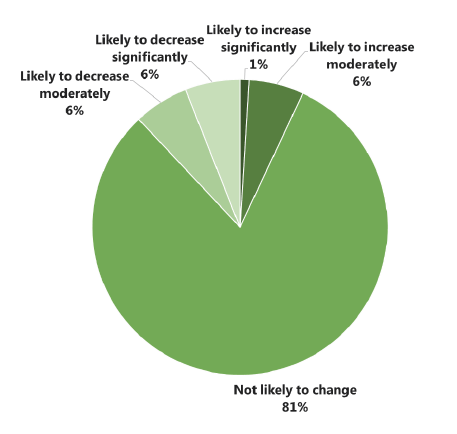
4.18 Consistent with previous figures, only just under a quarter (24%) of those with rental or mortgage costs said these were regularly reviewed while almost six in ten (57%) said they were not, as shown in the chart below.
Figure 4.8 Q Does your rent get regularly reviewed? (Base: 351)
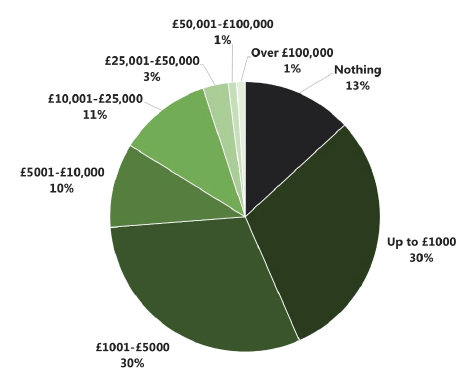
4.19 A very small number of crofters (56) reported the date of their last rent review. As shown in Figure 4.9, of those whose costs were regularly reviewed, just over two thirds said their rent had been reviewed in the last two years, since 2016 (68%) a further 8% stated they had been reviewed in 2015. A third of crofters (33%) did not state when their rent was last reviewed.
Figure 4.9 Q When was your rent last reviewed? (Base: 56)
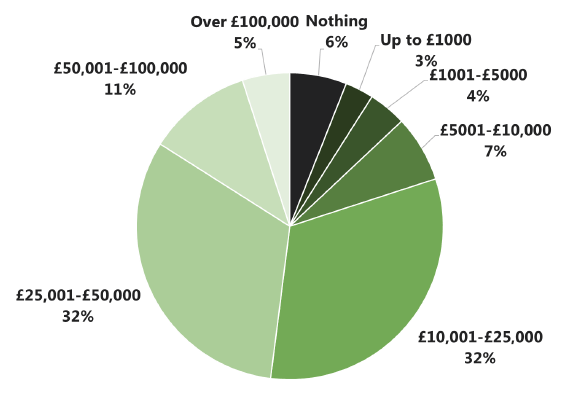
4.20 Those whose rent was reviewed were also asked when it is next due to be reviewed. While this question also produced a very small base (31), as seen in Figure 4.10 the most common dates for the next review were in 2018 and 2019 with just under half of crofters expecting a review either this or next year (48%) and a further 28% expecting a review in 2020 or 2021. Almost two thirds of crofters whose rent is regularly reviewed, however, did not report the anticipated date of their next review.
Figure 4.10 Q When is it due for the next review? (Base: 31)
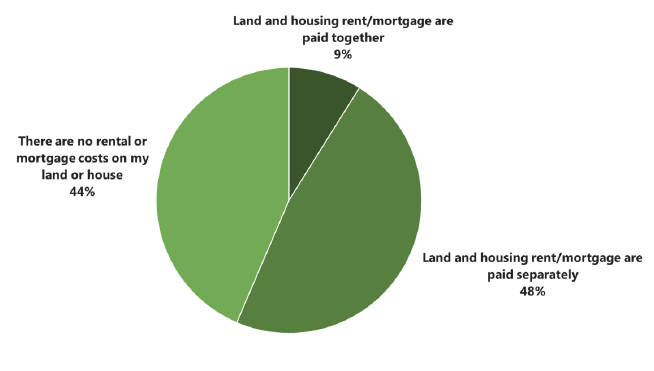
Contact
Email: Neil Davidson
There is a problem
Thanks for your feedback